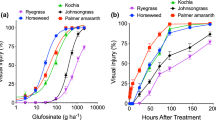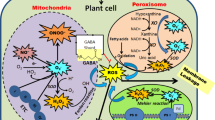Abstract
Glufosinate targets glutamine synthetase (GS), but its fast herbicidal action is triggered by reactive oxygen species (ROS). The relationship between GS inhibition and ROS accumulation was investigated in Amaranthus palmeri. Glufosinate’s fast action is light-dependent with no visual symptoms or ROS formation in the dark. Inhibition of GS leads to accumulation of ammonia and metabolites of the photorespiration pathway, such as glycolate and glyoxylate, as well as depletion of other intermediates such as glycine, serine, hydroxypyruvate, and glycerate. Exogenous supply of glycolate to glufosinate-treated plants enhanced herbicidal activity and dramatically increased hydrogen peroxide accumulation (possibly from peroxisomal glycolate oxidase activity). Glufosinate affected the balance between ROS generation and scavenging. The activity of superoxide dismutase, catalase, ascorbate peroxidase, and glutathione reductase increased after glufosinate treatment in an attempt to quench the nascent ROS burst. Low doses of atrazine and dinoseb were used to investigate the sources of ROS by manipulating photosynthetic electron transport and oxygen (O2) evolution. ROS formation depended on electron flow and O2 evolution in photosystem II (PSII). Inhibition of GS disrupted photorespiration, carbon assimilation, and linear electron flow in the light reactions. Consequently, the antioxidant machinery and the water–water cycle are overwhelmed in the presence of light and glufosinate. The O2 generated by the splitting of water in PSII becomes the acceptor of electrons, generating ROS. The cascade of events leads to lipid peroxidation and forms the basis for the fast action of glufosinate.






Similar content being viewed by others
References
Aebi H (1984) Catalase in vitro. Methods Enzymol 105:121–126. https://doi.org/10.1016/S0076-6879(84)05016-3
Apel K, Hirt H (2004) Reactive oxygen species: metabolism, oxidative stress, and signal transduction. Annu Rev Plant Biol 55(1):373–399. https://doi.org/10.1146/annurev.arplant.55.031903.141701
Asada K (1999) The water-water cycle in chloroplasts: scavenging of active oxygens and dissipation of excess photons. Annu Rev Plant Physiol Plant Mol Biol 50(1):601–639. https://doi.org/10.1146/annurev.arplant.50.1.601
Asada K (2006) Production and scavenging of reactive oxygen species in chloroplasts and their functions. Plant Physiol 141(2):391–396. https://doi.org/10.1104/pp.106.082040
Barber J, Archer MD (2001) P680, the primary electron donor of photosystem II. J Photochem Photobiol, A 142(2):97–106. https://doi.org/10.1016/S1010-6030(01)00503-2
Bayer E, Gugel KH, Hägele K, Hagenmaier H, Jessipow S, König WA, Zähner H (1972) Stoffwechselprodukte von Mikroorganismen. 98. Mitteilung. Phosphinothricin und Phosphinothricyl-Alanyl-Alanin. Helv Chim Acta 55(1):224–239. https://doi.org/10.1002/hlca.19720550126
Beyer WF, Fridovich I (1987) Assaying for superoxide dismutase activity: some large consequences of minor changes in conditions. Anal Biochem 161(2):559–566. https://doi.org/10.1016/0003-2697(87)90489-1
Busi R, Goggin DE, Heap IM, Horak MJ, Jugulam M, Masters RA, Napier RM, Riar DS, Satchivi NM, Torra J (2018) Weed resistance to synthetic auxin herbicides. Pest Manage Sci 74(10):2265–2276. https://doi.org/10.1002/ps.4823
Cadenas E (1989) Biochemistry of oxygen toxicity. Annu Rev Biochem 58(1):79–110. https://doi.org/10.1146/annurev.bi.58.070189.000455
Campbell WJ, Ogren WL (1990) Glyoxylate inhibition of ribulosebisphosphate carboxylase/oxygenase activation in intact, lysed, and reconstituted chloroplasts. Photosynth Res 23(3):257–268. https://doi.org/10.1007/BF00034856
Coetzer E, Al-Khatib K (2001) Photosynthetic inhibition and ammonium accumulation in Palmer amaranth after glufosinate application. Weed Sci 49(4):454–459. https://doi.org/10.1614/0043-1745(2001)049[0454:PIAAAI]2.0.CO;2
Corpas FJ, Barroso JB, del Río LA (2001) Peroxisomes as a source of reactive oxygen species and nitric oxide signal molecules in plant cells. Trends Plant Sci 6(4):145–150. https://doi.org/10.1016/S1360-1385(01)01898-2
Dayan FE, Barker AL, Bough R, Ortiz M, Takano HK, Duke SO (2019) Herbicide mechanisms of action and resistance. In: Moo-Young M (ed) Comprehensive biotechnology, vol 4. Elsevier, Amsterdam, p 4826
Dayan FE, Duke SO (2014) Natural compounds as next-generation herbicides. Plant Physiol 166(3):1090. https://doi.org/10.1104/pp.114.239061
Dayan FE, Owens DK, Corniani N, Silva FML, Watson SB, Howell JL, Shaner DL (2015) Biochemical markers and enzyme assays for herbicide mode of action and resistance studies. Weed Sci 63(sp1):23–63. https://doi.org/10.1614/WS-D-13-00063.1
Demidchik V (2015) Mechanisms of oxidative stress in plants: from classical chemistry to cell biology. Environ Exp Bot 109:212–228. https://doi.org/10.1016/j.envexpbot.2014.06.021
Duke SO (2011) Comparing conventional and biotechnology-based pest management. J Agric Food Chem 59(11):5793–5798. https://doi.org/10.1021/jf200961r
Edwards JW, Coruzzi GM (1989) Photorespiration and light act in concert to regulate the expression of the nuclear gene for chloroplast glutamine synthetase. Plant Cell 1(2):241. https://doi.org/10.1105/tpc.1.2.241
Fryer MJ, Oxborough K, Mullineaux PM, Baker NR (2002) Imaging of photo-oxidative stress responses in leaves. J Exp Bot 53(372):1249–1254. https://doi.org/10.1093/jexbot/53.372.1249
Gill SS, Tuteja N (2010) Reactive oxygen species and antioxidant machinery in abiotic stress tolerance in crop plants. Plant Physiol Biochem 48(12):909–930. https://doi.org/10.1016/j.plaphy.2010.08.016
González-Moro B, Lacuesta M, Becerril JM, Gonzalez-Murua C, Muñoz-Rueda A (1997) Glycolate accumulation causes a decrease of photosynthesis by inhibiting RUBISCO activity in maize. J Plant Physiol 150(4):388–394. https://doi.org/10.1016/S0176-1617(97)80087-9
Halliwell B (1987) Oxidative damage, lipid peroxidation and antioxidant protection in chloroplasts. Chem Phys Lipid 44(2):327–340. https://doi.org/10.1016/0009-3084(87)90056-9
Hodges DM, DeLong JM, Forney CF, Prange RK (1999) Improving the thiobarbituric acid-reactive-substances assay for estimating lipid peroxidation in plant tissues containing anthocyanin and other interfering compounds. Planta 207(4):604–611. https://doi.org/10.1007/s004250050524
Hudson GS, Evans JR, von Caemmerer S, Arvidsson YBC, Andrews TJ (1992) Reduction of ribulose-1,5-bisphosphate carboxylase/oxygenase content by antisense RNA reduces photosynthesis in transgenic tobacco plants. Plant Physiol 98(1):294. https://doi.org/10.1104/pp.98.1.294
Kerchev P, Waszczak C, Lewandowska A, Willems P, Shapiguzov A, Li Z, Alseekh S, Mühlenbock P, Hoeberichts FA, Huang J, Van Der Kelen K, Kangasjärvi J, Fernie AR, De Smet R, Van de Peer Y, Messens J, Van Breusegem F (2016) Lack of GLYCOLATE OXIDASE1, but not GLYCOLATE OXIDASE2, attenuates the photorespiratory phenotype of CATALASE2-deficient Arabidopsis. Plant Physiol 171(3):1704. https://doi.org/10.1104/pp.16.00359
Kozaki A, Takeba G (1996) Photorespiration protects C3 plants from photooxidation. Nature 384(6609):557–560. https://doi.org/10.1038/384557a0
Kumar PA, Nair TVR, Abrol YP (1984) Effect of photorespiratory metabolites, inhibitors and methionine sulphoximine on the accumulation of ammonia in the leaves of mung bean and Amaranthus. Plant Sci Lett 33(3):303–307. https://doi.org/10.1016/0304-4211(84)90021-X
Laloi C, Przybyla D, Apel K (2006) A genetic approach towards elucidating the biological activity of different reactive oxygen species in Arabidopsis thaliana. J Exp Bot 57(8):1719–1724. https://doi.org/10.1093/jxb/erj183
Leason M, Cunliffe D, Parkin D, Lea PJ, Miflin BJ (1982) Inhibition of pea leaf glutamine synthetase by methionine sulphoximine, phosphinothricin and other glutamate analogues. Phytochemistry 21(4):855–857. https://doi.org/10.1016/0031-9422(82)80079-4
Leff B, Ramankutty N, Foley JA (2004) Geographic distribution of major crops across the world. Global Biogeochem Cycles. https://doi.org/10.1029/2003GB002108
Lisec J, Schauer N, Kopka J, Willmitzer L, Fernie AR (2006) Gas chromatography mass spectrometry–based metabolite profiling in plants. Nat Protoc 1(1):387. https://doi.org/10.1038/nprot.2006.59
Lu Y, Li Y, Yang Q, Zhang Z, Chen Y, Zhang S, Peng X-X (2014) Suppression of glycolate oxidase causes glyoxylate accumulation that inhibits photosynthesis through deactivating Rubisco in rice. Physiol Plant 150(3):463–476. https://doi.org/10.1111/ppl.12104
Molin WT, Khan RA (1995) Microbioassays to determine the activity of membrane disrupter herbicides. Pestic Biochem Physiol 53(3):172–179. https://doi.org/10.1006/pest.1995.1065
Møller IM (2001) Plant mitochondria and oxidative stress: Electron transport, NADPH turnover, and metabolism of reactive oxygen species. Annu Rev Plant Physiol Plant Mol Biol 52(1):561–591. https://doi.org/10.1146/annurev.arplant.52.1.561
Morales M, Munné-Bosch S (2019) Malondialdehyde: facts and artifacts. Plant Physiol 180(3):1246–1250. https://doi.org/10.1104/pp.19.00405
Nakano Y, Asada K (1981) Hydrogen peroxide is scavenged by ascorbate-specific peroxidase in spinach chloroplasts. Plant Cell Physiol 22(5):867–880. https://doi.org/10.1093/oxfordjournals.pcp.a076232
Osmond CB, Grace SC (1995) Perspectives on photoinhibition and photorespiration in the field: quintessential inefficiencies of the light and dark reactions of photosynthesis? J Exp Bot 46:1351–1362
Platt SG, Anthon GE (1981) Ammonia accumulation and inhibition of photosynthesis in methionine sulfoximine treated spinach. Plant Physiol 67(3):509–513. https://doi.org/10.1104/pp.67.3.509
Pospíšil P (2009) Production of reactive oxygen species by photosystem II. Biochem Biophys Acta 1787(10):1151–1160. https://doi.org/10.1016/j.bbabio.2009.05.005
Ruuska SA, Badger MR, Andrews TJ, von Caemmerer S (2000) Photosynthetic electron sinks in transgenic tobacco with reduced amounts of Rubisco: little evidence for significant Mehler reaction. J Exp Bot 51(suppl_1):357–368. https://doi.org/10.1093/jexbot/51.suppl_1.357
Sauer H, Wild A, Rühle W (1987) The effect of phosphinothricin (glufosinate) on photosynthesis II. The causes of inhibition of photosynthesis. Z Naturforschung C 42(3):270–278. https://doi.org/10.1515/znc-1987-0317
Seto H, Sasaki T, Imai S, Tsuruoka T, Ogawa H, Satoh A, Inouye S, Niida T, Otake N (1983) Studies on the biosynthesis of bialaphos (SF-1293). J Antibiot 36(1):96–98. https://doi.org/10.7164/antibiotics.36.96
Smith IK, Vierheller TL, Thorne CA (1988) Assay of glutathione reductase in crude tissue homogenates using 5,5′-dithiobis(2-nitrobenzoic acid). Anal Biochem 175(2):408–413. https://doi.org/10.1016/0003-2697(88)90564-7
Strauch E, Wohlleben W, Pühler A (1988) Cloning of a phosphinothricin N-acetyltransferase gene from Streptomyces viridochromogenes Tü494 and its expression in Streptomyces lividans and Escherichia coli. Gene 63(1):65–74. https://doi.org/10.1016/0378-1119(88)90546-X
Tachibana K, Watanabe T, Sekizawa Y, Takematsu T (1986) Accumulation of ammonia in plants treated with bialaphos. J Pest Sci 11(1):33–37. https://doi.org/10.1584/jpestics.11.33
Takahashi S, Badger MR (2011) Photoprotection in plants: a new light on photosystem II damage. Trends Plant Sci 16(1):53–60. https://doi.org/10.1016/j.tplants.2010.10.001
Takano HK, Beffa R, Preston C, Westra P, Dayan FE (2019) Reactive oxygen species trigger the fast action of glufosinate. Planta 249(6):1837–1849. https://doi.org/10.1007/s00425-019-03124-3
Takano HK, Beffa RS, Preston C, Westra P, Dayan FE (2020) Physiological factors affecting uptake and translocation of glufosinate. J Agric Food Chem 68(10):3026–3032. https://doi.org/10.1021/acs.jafc.9b07046
Triantaphylidès C, Havaux M (2009) Singlet oxygen in plants: production, detoxification and signaling. Trends Plant Sci 14(4):219–228. https://doi.org/10.1016/j.tplants.2009.01.008
Ullrich WR, Ullrich-Eberius CI, Köcher H (1990) Uptake of glufosinate and concomitant membrane potential changes in Lemna gibba G1. Pestic Biochem Physiol 37(1):1–11. https://doi.org/10.1016/0048-3575(90)90103-9
Wild A, Sauer H, Rühle W (1987) The effect of phosphinothricin (glufosinate) on photosynthesis I. Inhibition of photosynthesis and accumulation of ammonia. Z Naturforschung C 42(3):263–269. https://doi.org/10.1515/znc-1987-0316
Zelitch I, Schultes NP, Peterson RB, Brown P, Brutnell TP (2009) High glycolate oxidase activity is required for survival of maize in normal air. Plant Physiol 149(1):195–204. https://doi.org/10.1104/pp.108.128439
Funding
This research was funded by BASF Corporation.
Author information
Authors and Affiliations
Corresponding author
Ethics declarations
Conflict of interest
All authors declare that they have no conflict of interest.
Additional information
Publisher's Note
Springer Nature remains neutral with regard to jurisdictional claims in published maps and institutional affiliations.
Electronic supplementary material
Below is the link to the electronic supplementary material.
Rights and permissions
About this article
Cite this article
Takano, H.K., Beffa, R., Preston, C. et al. A novel insight into the mode of action of glufosinate: how reactive oxygen species are formed. Photosynth Res 144, 361–372 (2020). https://doi.org/10.1007/s11120-020-00749-4
Received:
Accepted:
Published:
Issue Date:
DOI: https://doi.org/10.1007/s11120-020-00749-4




